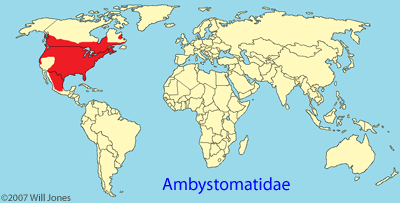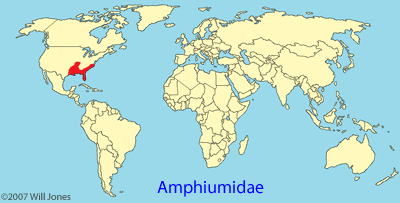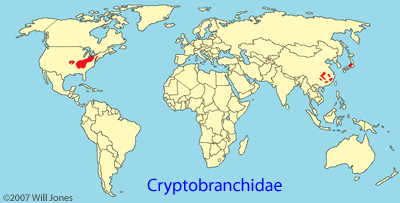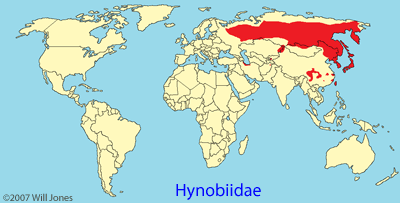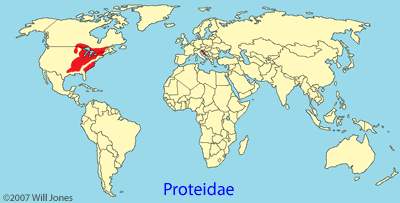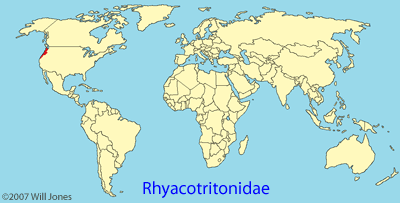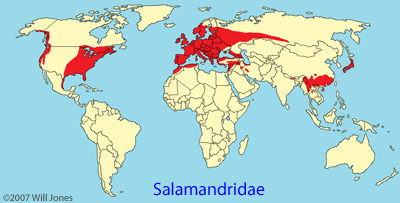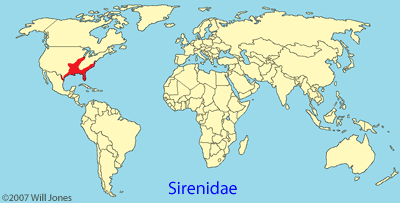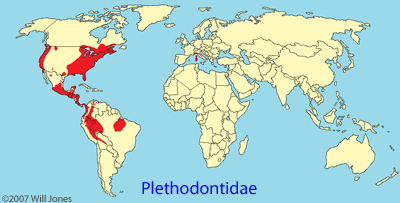Caudate Families
Quick Links
The tailed amphibians known as caudates make up around 9% of the world's amphibian species. Order Caudata contains 9 families that are mainly distributed across the northern temperate regions of the world where cool and moist environments occur. A small number of species inhabit sub-tropical and tropical regions. The largest density of species is found in North America, where 8 of the 9 families are represented.
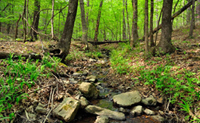
Woodland stream habitat. Photo: John Clare
Members of the order Caudata are commonly known as salamanders but also include newts, a group of species belonging to the family Salamandridae. A large proportion has a biphasic life cycle, starting life as aquatic gilled larvae that later metamorphosing into terrestrial adults. Adults usually follow seasonal breeding activity, migrating to breeding sites to court and lay eggs. Caudates are generally nocturnal and forage for food at night. Terrestrial adults generally remain hidden under logs and rocks during the day, while aquatic caudates live on the bottoms of streams or ponds, taking refuge under stones and detritus.
Families and Genera
The order Caudata contains nearly 600 species belonging to 9 families. The exact numbers and names of species change as species are discovered or redefined. Recent taxonomic changes are listed in the Taxonomic Revisions page. If you are primarily interested in captive care information, see Caresheets.

Ambystoma annulatum
Photo: John Clare
In 2006 the family Dicamptodon was placed back within the family Ambystomatidae. The genus Dicamptodon contains the largest terrestrial salamanders, reaching up to 35 cm (13.8 in.) in length. All species are distributed along the Pacific coast of the western United States where they inhabit coniferous forests with streams and springs. Larvae can take up to 4.5 years to reach metamorphosis, although one species, D. copei, lacks metamorphosis.

Amphiuma means
Photo: Pierson Hill
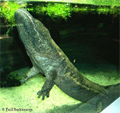
Andrias davidianus
Photo: Paul Bachhausen

Hynobius tokyoensis egg sacs
Photo: Tim Johnson

Necturus maculosus
Photo: Mike Graziano

Rhyacotriton kezeri
Photo: Josef Uyeda

Ommatotriton ophryticus
Photo: Jean-Pierre Collet
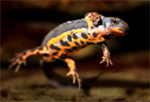
Cynops pyrrhogaster
Photo: Mark Aartse-Tuyn
All Salamandrids produce toxic skin secretions as a defense mechanism and often display bright warning coloration. Some of the most striking examples of warning coloration can be seen in Salamandra species that sport yellow or orange patterning against a black background. Species with enlarged parotoid glands usually highlight them with conspicuous colors. Tetrodotoxin, the neurotoxin in skin secretions is found in the highest concentration in members of the genus Taricha; levels present are potent enough to kill most predators.

P. striatus spheniscus
Photo: Pierson Hill

Pseudotriton ruber ruber
Photo: Jim Anno

Plethodon ouachitae
Photo: John Clare
Plethodontids are highly variable in shape and size. One species is less than 3 cm (1.2 in.) in length when fully grown, whereas others reach over 30 cm (12 in.) in length. All Plethodontidae are lungless and respire through their skin, which needs to be kept moist as a consequence. One feature that distinguishes the family is the presence of a vertical groove found on the upper lip, known as the naso-labial groove. Male salamanders often have protuberances called cirri associated with these grooves, and both of these adaptations are thought to enhance the animals' chemoreception during breeding.
In 2005 a new species of Plethodontid was surprisingly found in Korea, the first of its kind in Asia, and given its own genus, Karsenia. This discovery along with the presence of Speleomantes in Europe, suggests that family Plethodontidae was once distributed much more widely throughout the northern continents.
References
- Duellman, William E. and Trueb, Linda. 1994. Biology of Amphibians. Johns Hopkins University Press.
- Good, David A. and Wake, David B. 1992. Geographic variation and speciation in the Torrent Salamanders of the genus Rhyacotriton (Caudata: Rhyacotritonidae). Zoology 126: 1-91.
- Larson, Allen, Wake, David, and Devitt, Tom. Tree of Life Web Project. http://tolweb.org/Caudata. Accessed January 2010.
- AmphibiaWeb - http://www.amphibiaweb.org. Accessed January 2010.
- Petranka, James W. 1998. Salamanders of the United States and Canada. Smithsonian Institute Press.
- Thorn, Robert and Raffaëlli, Jean. Les Salamandres de l'Ancien Monde. 2001, Societé Nouvelle des Editions Boubée Paris.
Posted April 2010. Written and compiled by Mark Aartse-Tuyn, Ryan St. Laurent, Jennifer Macke & Janice Williams. Map images by Will Jones.


